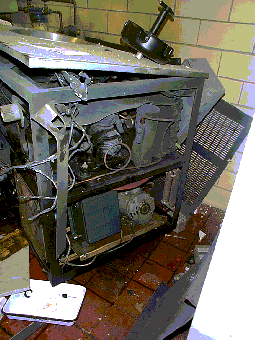Centrifuge Explosion
History:
- Beckman Instruments Urgent Corrective Action Notice, (Adobe Acrobat format) dated June 22, 1984, which describes two centrifuge accidents that were similar to the accident at Cornell. The letter goes on to explain that operators of Beckman centrifuges must use only the specific types of rotors that are approved by Beckman for each specific model of centrifuge. The letter provides the complete list of approved rotors for all model L, L2, L3 and L4 centrifuges. Note: While this letter was sent to owners of Beckman centrifuges 15 years ago, the information is still appropriate for these models. It is very important that operators of these units follow these guidelines.
- Sorvall Rotor Care Guide which explains how to care for and prevent damage to rotors, how to inspect rotors for damage, and rotor warranties. (Note: this is an Adobe Acrobat file that is greater than 10 MB in size.)
- Beckman Coulter Rotor Safety Guide (Adobe Acrobat format) which explains why rotors can fail, how to minimize the risk of rotor failures and rotor warranties.
A campus laboratory was seriously damaged when the rotor of an ultracentrifuge failed while in use. Flying metal fragments damaged walls, the ceiling and other equipment. The shock wave blew out the laboratory's windows and shook down shelves.
Description of Accident

On December 16, 1998, milk samples were running in a Beckman.L2-65B ultracentrifuge using a large aluminum rotor (a rotor is a large metal object that holds the individual sample tubes and is connected to the spin drive of the centrifuge). The rotor had been used for this procedure many times before. Approximately one hour into the operation, the rotor failed due to excessive mechanical stress caused by the "G" forces of the high rotation speed. The subsequent explosion completely destroyed the centrifuge (picture 1)(picture 2).
The safety shielding in the unit did not contain all the metal fragments. The half-inch thick sliding steel door on top of the unit buckled allowing fragments, including the steel rotor top, to escape (picture). Fragments ruined a nearby refrigerator and an ultra-cold freezer in addition to making holes in the walls and ceiling. The unit itself was propelled sideways and damaged cabinets and shelving that contained over a hundred containers of chemicals (picture). Fortunately, sliding cabinet doors prevented the containers from falling to the floor and breaking. A shock wave from the accident shattered all four windows in the room. The shock wave also destroyed the control system for an incubator and shook an interior wall causing shelving on the wall to collapse (picture). Fortunately the room was not occupied at the time and there were no personal injuries.
The cause of the accident is believed to be the use of a model of rotor that was not approved by Beckman for use in a model L2-65B ultracentrifuge.
Preventing Centrifuge Accidents
Rotors on high-speed centrifuge and ultracentrifuge units are subjects to powerful mechanical stress that can result in rotor failure. In addition, improper loading and balancing of rotors can cause the rotors to break loose while spinning. Everyone using this type of equipment needs to know the proper operating procedures for the specific unit being operated, including how to select, load, balance and clean the rotor. These procedures are explained in the unit's operating manual.
It is also necessary to "de-rate" some rotors (limiting the maximum speed at which the rotor is used to some level below the maximum speed listed for the rotor when new) based on the amount of use the rotor has received. This requires that operators maintain a comprehensive use log for each rotor. These procedures are explained in the operating manual.
Laboratory supervisors must see to it that operators of this type of equipment are properly trained in the selection, care and use of rotors. In the event a trained and experienced operator is not available to train new operators, contact the service representative for the unit and arrange an orientation program. Check the contact list below for details. If you are unable to reach the manufacturer, please contact REM Industrial Hygiene and Lab Safety section.
In the event of operating problems with high-speed centrifuge or ultracentrifuge units, or signs of wear or damage to rotors, the equipment should be taken out of service immediately and clearly marked "Warning -DO NOT USE" until checked by an authorized service representative. Check the attached contact list.
Special Hazard Warning for Older Equipment
Older equipment does not have all the safety features built into new units. They are more likely to experience rotor failures and they are more likely to cause injuries when they fail. It is critical that all safety and maintenance procedures specified by the manufacturer are followed. Based on the investigation of the December 16, 1998 Cornell accident, it was learned that Beckman L2 and L3 series ultracentrifuges have special operating procedures and restrictions to reduce the risk of damage and injuries. This includes an orange decal on the sliding door that specifies the rotor models that are safe to use in a particular unit (picture).
REM would like to provide specific safety information to owners of Beckman L2 or L3 ultracentrifuges at Purdue. If you have an operable unit if this type, please email REM Lab Safety and this information will be sent to you.